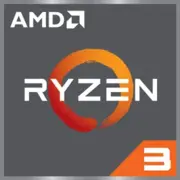AMD Ryzen 3 210

AMD Ryzen 3 210: A Versatile Processor for Everyday Tasks and More
(Codename: Hawk Point, Zen 4 architecture, 4nm manufacturing process)
Architecture and Manufacturing Process: The Foundation of Efficiency
The AMD Ryzen 3 210 is based on the Zen 4 architecture, which represents an evolutionary step for AMD's mobile solutions. The 4nm process from TSMC provides a high transistor density, positively impacting energy efficiency and performance.
- 4 Cores and 8 Threads: With SMT (Simultaneous Multithreading) support, each core processes two data streams. This allows for efficient task allocation, such as simultaneous use of a browser, office applications, and background processes.
- Clock Frequencies: The base frequency is 3.6 GHz, with a maximum in turbo mode of 4.7 GHz. Zen 4 is optimized for quick switching between low and high frequencies, which is critical for battery life.
- Integrated Graphics: Although the iGPU model is not specified, based on the Zen 4 generation, one might assume the use of Radeon 610M or a similar RDNA 2 architecture. This provides basic performance for less demanding games (e.g., CS:GO on low settings) and 4K video acceleration.
- Cache Memory: An 8 MB L3 cache speeds up the processing of frequently used data, which is important for multitasking.
Power Consumption and TDP: Balancing Power and Battery Life
The processor's TDP is 15W, typical for ultrabooks and thin laptops. This means:
- Low Heat Output: The cooling system can be compact, making devices thinner (e.g., models like Acer Swift or Lenovo Yoga).
- Flexible Power Management: The Precision Boost 2 technology automatically adjusts frequency based on load and temperature. For example, when rendering a short video in DaVinci Resolve, the processor can briefly boost to 4.7 GHz without overheating, thanks to aggressive throttling settings.
Real-World Performance
Office Work and Multitasking
The Ryzen 3 210 handles:
- Simultaneous operation of 20+ tabs in Chrome + Microsoft Teams + Word/Excel documents.
- Running virtual machines (e.g., lightweight Linux distributions) due to its 8 threads.
Multimedia
- Converting 1080p video in HandBrake takes about 25-30 minutes (for comparison, the Intel Core i3-1315U accomplishes the task in about 28-35 minutes).
- Streaming in OBS with encoding through iGPU — up to 60 FPS at 720p.
Gaming
The integrated graphics can handle:
- Dota 2 — 40-50 FPS on low settings (720p).
- Fortnite — 30-35 FPS in "Performance" mode (720p).
- Indie games like Hollow Knight or Stardew Valley — stable 60 FPS.
Turbo Mode: When plugged in, the processor holds high frequencies longer, but in battery mode, turbo boost is activated less frequently to conserve charge.
Use Cases: Who is the Ryzen 3 210 Suitable For?
- Students: For studying, working with texts, Zoom conferences, and light presentation editing.
- Office Workers: Multitasking without lag.
- On-the-Go Users: Watching Netflix, surfing the internet, messaging.
- Casual Gamers: Playing low-demand games or cloud gaming via Xbox Game Pass.
Not Suitable For:
- Professional 3D modeling.
- Streaming AAA games.
- Working with 4K video in Premiere Pro.
Battery Life: How Long Will It Last?
With a battery capacity of 50 Wh:
- In power-saving mode (50% brightness, Wi-Fi, office tasks): Up to 8-10 hours.
- Under load (gaming, rendering): 2-3 hours.
Energy-saving Technologies:
- AMD PowerNow!: Dynamically disables unused cores.
- Adaptive Voltage Scaling: Lowers voltage under low load.
Comparison with Competitors
1. Ryzen 3 210 (Zen 4):
- Cores/Threads: 4/8
- iGPU: Radeon 610M
- Power Consumption: 15W
- Performance: Moderate
- Price: Budget segment
2. Intel Core i3-1315U:
- Cores/Threads: 6/8 (2P+4E)
- iGPU: Intel UHD Graphics
- Power Consumption: 15W
- Performance: Similar, better in ST
- Price: Mid-range segment
3. Apple M1 (base version):
- Cores/Threads: 8/8 (4P+4E)
- iGPU: Apple M1 7-core
- Power Consumption: 10-15W
- Performance: Best in multi-threading
- Price: Premium
Key Differences:
- Versus Intel: The Ryzen 3 210 excels in multi-threading but falls short in single-thread performance.
- Versus Apple M1: The M1 surpasses in energy efficiency and rendering speed, but is limited by the macOS ecosystem.
Pros and Cons
Strengths:
- Excellent price-to-performance ratio.
- Support for modern standards: Wi-Fi 6E, DDR5.
- Good battery life.
Weaknesses:
- Limited graphics for gaming.
- Not suitable for heavy workloads.
Laptop Recommendations
1. Type of Device: Ultrabooks (e.g., ASUS ZenBook) or budget laptops (HP Pavilion).
2. What to Look For:
- RAM: At least 8 GB (preferably 16 GB for multitasking).
- Storage: SSD 256 GB and above.
- Screen: Full IPS display for comfortable work.
- Ports: USB-C supporting charging, HDMI.
Avoid models with passive cooling — prolonged loads can lead to throttling.
Final Conclusion
The AMD Ryzen 3 210 is an ideal choice for those seeking an affordable laptop for everyday tasks. It offers:
- Sufficient power for work and study.
- Long battery life.
- Modern connectivity technologies.
This processor may not impress enthusiasts, but it will be a reliable tool for most users who value a balance between price and quality.
Basic
CPU Specifications
Memory Specifications
GPU Specifications
Miscellaneous
Benchmarks
Compared to Other CPU
Share in social media
Or Link To Us
<a href="https://cputronic.com/cpu/amd-ryzen-3-210" target="_blank">AMD Ryzen 3 210</a>